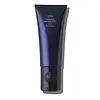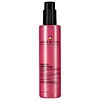What's inside
What's inside
 Key Ingredients
Key Ingredients

 Benefits
Benefits

 Concerns
Concerns

 Ingredients Side-by-side
Ingredients Side-by-side

Water
Skin ConditioningDimethicone
EmollientCyclopentasiloxane
EmollientDimethiconol
EmollientButylene Glycol
HumectantPhenyl Trimethicone
Skin ConditioningAcrylamide/Sodium Acryloyldimethyltaurate Copolymer
Emulsion StabilisingParfum
MaskingIsohexadecane
EmollientOleth-10
EmulsifyingChlorphenesin
AntimicrobialPolysorbate 80
EmulsifyingCyclohexasiloxane
EmollientTetrasodium EDTA
Panthenol
Skin ConditioningSorbic Acid
PreservativeSorbitan Oleate
EmulsifyingGlycerin
HumectantBenzophenone-4
UV AbsorberHelianthus Annuus Seed Extract
Skin ConditioningCinnamidopropyltrimonium Chloride
Styrax Benzoin Resin Extract
MaskingWheat Amino Acids
Skin ConditioningHydrolyzed Jojoba Protein
Skin ConditioningHydrolyzed Rice Protein
Skin ConditioningTin Oxide
AbrasiveHydrolyzed Soy Protein
HumectantCystine Bis-Pg-Propyl Silanetriol
Skin ConditioningHydrolyzed Vegetable Protein Pg-Propyl Silanetriol
Skin ConditioningPhenoxyethanol
PreservativeHydrolyzed Vegetable Protein
Skin ConditioningPhospholipids
Skin ConditioningKaempferia Galanga Root Extract
Skin ConditioningLeontopodium Alpinum Extract
Skin ConditioningPotassium Sorbate
PreservativeCitrullus Lanatus Fruit Extract
Skin ConditioningSodium Benzoate
MaskingCitric Acid
BufferingPotassium Benzoate
PreservativeLeuconostoc/Radish Root Ferment Filtrate
AntimicrobialCitrulline
Skin ConditioningDisodium EDTA
Ethylhexylglycerin
Skin ConditioningTocopheryl Acetate
AntioxidantPPG-3 Benzyl Ether Myristate
EmollientLitchi Chinensis Pericarp Extract
Skin ConditioningMoringa Oleifera Seed Extract
Skin ConditioningBenzyl Alcohol
PerfumingAscorbyl Palmitate
AntioxidantRetinyl Palmitate
Skin ConditioningDisodium Phosphate
BufferingPentaerythrityl Tetra-Di-T-Butyl Hydroxyhydrocinnamate
AntioxidantBenzyl Benzoate
AntimicrobialLimonene
PerfumingLinalool
PerfumingHexyl Cinnamal
PerfumingCitral
PerfumingMica
Cosmetic ColorantCI 77891
Cosmetic ColorantWater, Dimethicone, Cyclopentasiloxane, Dimethiconol, Butylene Glycol, Phenyl Trimethicone, Acrylamide/Sodium Acryloyldimethyltaurate Copolymer, Parfum, Isohexadecane, Oleth-10, Chlorphenesin, Polysorbate 80, Cyclohexasiloxane, Tetrasodium EDTA, Panthenol, Sorbic Acid, Sorbitan Oleate, Glycerin, Benzophenone-4, Helianthus Annuus Seed Extract, Cinnamidopropyltrimonium Chloride, Styrax Benzoin Resin Extract, Wheat Amino Acids, Hydrolyzed Jojoba Protein, Hydrolyzed Rice Protein, Tin Oxide, Hydrolyzed Soy Protein, Cystine Bis-Pg-Propyl Silanetriol, Hydrolyzed Vegetable Protein Pg-Propyl Silanetriol, Phenoxyethanol, Hydrolyzed Vegetable Protein, Phospholipids, Kaempferia Galanga Root Extract, Leontopodium Alpinum Extract, Potassium Sorbate, Citrullus Lanatus Fruit Extract, Sodium Benzoate, Citric Acid, Potassium Benzoate, Leuconostoc/Radish Root Ferment Filtrate, Citrulline, Disodium EDTA, Ethylhexylglycerin, Tocopheryl Acetate, PPG-3 Benzyl Ether Myristate, Litchi Chinensis Pericarp Extract, Moringa Oleifera Seed Extract, Benzyl Alcohol, Ascorbyl Palmitate, Retinyl Palmitate, Disodium Phosphate, Pentaerythrityl Tetra-Di-T-Butyl Hydroxyhydrocinnamate, Benzyl Benzoate, Limonene, Linalool, Hexyl Cinnamal, Citral, Mica, CI 77891
Water
Skin ConditioningC13-16 Isoparaffin
SolventGlycerin
HumectantPolyacrylamide
Dimethicone
EmollientButylene Glycol
HumectantC13-14 Isoparaffin
EmollientCitric Acid
BufferingSodium Benzoate
MaskingCaprylyl Glycol
EmollientOctyldodecanol
EmollientParfum
MaskingPhenoxyethanol
PreservativeOleth-10
EmulsifyingPolysorbate 20
EmulsifyingTrideceth-9 Pg-Amodimethicone
Skin ConditioningLaureth-7
EmulsifyingHydroxypropyl Guar
Emulsion StabilisingTocopherol
AntioxidantCocos Nucifera Oil
MaskingXylose
HumectantTrideceth-12
EmulsifyingHelianthus Annuus Seed Extract
Skin ConditioningAscorbyl Glucoside
AntioxidantBenzophenone-4
UV AbsorberCoumarin
PerfumingWater, C13-16 Isoparaffin, Glycerin, Polyacrylamide, Dimethicone, Butylene Glycol, C13-14 Isoparaffin, Citric Acid, Sodium Benzoate, Caprylyl Glycol, Octyldodecanol, Parfum, Phenoxyethanol, Oleth-10, Polysorbate 20, Trideceth-9 Pg-Amodimethicone, Laureth-7, Hydroxypropyl Guar, Tocopherol, Cocos Nucifera Oil, Xylose, Trideceth-12, Helianthus Annuus Seed Extract, Ascorbyl Glucoside, Benzophenone-4, Coumarin
 Reviews
Reviews

Ingredients Explained
These ingredients are found in both products.
Ingredients higher up in an ingredient list are typically present in a larger amount.
Benzophenone-4 is a water-soluble chemical sunscreen.
It protects in the UV-B range, but is considered a secondary UV absorber. This means that it needs to be paired with other sunscreen ingredients to provide effective protection.
Typically, it's used in cosmetic products to protect them from deterioration caused by UV rays. This is why you'll find it in a lot of products that aren't sunscreens.
Learn more about Benzophenone-4Butylene Glycol (or BG) is used within cosmetic products for a few different reasons:
Overall, Butylene Glycol is a safe and well-rounded ingredient that works well with other ingredients.
Though this ingredient works well with most skin types, some people with sensitive skin may experience a reaction such as allergic rashes, closed comedones, or itchiness.
Learn more about Butylene GlycolCitric Acid is an alpha hydroxy acid (AHA) naturally found in citrus fruits like oranges, lemons, and limes.
Like other AHAs, citric acid can exfoliate skin by breaking down the bonds that hold dead skin cells together. This helps reveal smoother and brighter skin underneath.
However, this exfoliating effect only happens at high concentrations (20%) which can be hard to find in cosmetic products.
Due to this, citric acid is usually included in small amounts as a pH adjuster. This helps keep products slightly more acidic and compatible with skin's natural pH.
In skincare formulas, citric acid can:
While it can provide some skin benefits, research shows lactic acid and glycolic acid are generally more effective and less irritating exfoliants.
Most citric acid used in skincare today is made by fermenting sugars (usually from molasses). This synthetic version is identical to the natural citrus form but easier to stabilize and use in formulations.
Read more about some other popular AHA's here:
Learn more about Citric AcidDimethicone is a type of synthetic silicone created from natural materials such as quartz.
What it does:
Dimethicone comes in different viscosities:
Depending on the viscosity, dimethicone has different properties.
Ingredients lists don't always show which type is used, so we recommend reaching out to the brand if you have questions about the viscosity.
This ingredient is unlikely to cause irritation because it does not get absorbed into skin. However, people with silicone allergies should be careful about using this ingredient.
Note: Dimethicone may contribute to pilling. This is because it is not oil or water soluble, so pilling may occur when layered with products. When mixed with heavy oils in a formula, the outcome is also quite greasy.
Learn more about DimethiconeGlycerin is already naturally found in your skin. It helps moisturize and protect your skin.
A study from 2016 found glycerin to be more effective as a humectant than AHAs and hyaluronic acid.
As a humectant, it helps the skin stay hydrated by pulling moisture to your skin. The low molecular weight of glycerin allows it to pull moisture into the deeper layers of your skin.
Hydrated skin improves your skin barrier; Your skin barrier helps protect against irritants and bacteria.
Glycerin has also been found to have antimicrobial and antiviral properties. Due to these properties, glycerin is often used in wound and burn treatments.
In cosmetics, glycerin is usually derived from plants such as soybean or palm. However, it can also be sourced from animals, such as tallow or animal fat.
This ingredient is organic, colorless, odorless, and non-toxic.
Glycerin is the name for this ingredient in American English. British English uses Glycerol/Glycerine.
Learn more about GlycerinHelianthus Annuus Seed Extract comes from sunflower seeds.
Sunflower seeds are rich in vitamin E. Studies show sunflowers contain antimicrobial and antioxidant properties.
The fatty acids found in sunflower seeds include (from highest amount to least): linoleic acid, myristic acid, palmitic acid, stearic acid, arachidic acid, oleic acid, and linolenic acid.
These fatty acids hydrate your skin. Emollients create a film on the skin to prevent moisture from escaping.
Learn more about Helianthus Annuus Seed ExtractOleth-10 comes from oleyl alcohol. It is an emulsifier that helps reduce surface tension of dirt and pollutants to be washed away.
Parfum is a catch-all term for an ingredient or more that is used to give a scent to products.
Also called "fragrance", this ingredient can be a blend of hundreds of chemicals or plant oils. This means every product with "fragrance" or "parfum" in the ingredients list is a different mixture.
For instance, Habanolide is a proprietary trade name for a specific aroma chemical. When used as a fragrance ingredient in cosmetics, most aroma chemicals fall under the broad labeling category of “FRAGRANCE” or “PARFUM” according to EU and US regulations.
The term 'parfum' or 'fragrance' is not regulated in many countries. In many cases, it is up to the brand to define this term.
For instance, many brands choose to label themselves as "fragrance-free" because they are not using synthetic fragrances. However, their products may still contain ingredients such as essential oils that are considered a fragrance by INCI standards.
One example is Calendula flower extract. Calendula is an essential oil that still imparts a scent or 'fragrance'.
Depending on the blend, the ingredients in the mixture can cause allergies and sensitivities on the skin. Some ingredients that are known EU allergens include linalool and citronellol.
Parfum can also be used to mask or cover an unpleasant scent.
The bottom line is: not all fragrances/parfum/ingredients are created equally. If you are worried about fragrances, we recommend taking a closer look at an ingredient. And of course, we always recommend speaking with a professional.
Learn more about ParfumPhenoxyethanol is a preservative that has germicide, antimicrobial, and aromatic properties. Studies show that phenoxyethanol can prevent microbial growth. By itself, it has a scent that is similar to that of a rose.
It's often used in formulations along with Caprylyl Glycol to preserve the shelf life of products.
Sodium Benzoate is a preservative. It's used in both cosmetic and food products to inhibit the growth of mold and bacteria. It is typically produced synthetically.
Both the US FDA and EU Health Committee have approved the use of sodium benzoate. In the US, levels of 0.1% (of the total product) are allowed.
Sodium benzoate works as a preservative by inhibiting the growth of bacteria inside of cells. It prevents the cell from fermenting a type of sugar using an enzyme called phosphofructokinase.
It is the salt of benzoic acid. Foods containing sodium benzoate include soda, salad dressings, condiments, fruit juices, wines, and snack foods.
Studies for using ascorbic acid and sodium benzoate in cosmetics are lacking, especially in skincare routines with multiple steps.
We always recommend speaking with a professional, such as a dermatologist, if you have any concerns.
Learn more about Sodium BenzoateWater. It's the most common cosmetic ingredient of all. You'll usually see it at the top of ingredient lists, meaning that it makes up the largest part of the product.
So why is it so popular? Water most often acts as a solvent - this means that it helps dissolve other ingredients into the formulation.
You'll also recognize water as that liquid we all need to stay alive. If you see this, drink a glass of water. Stay hydrated!
Learn more about Water